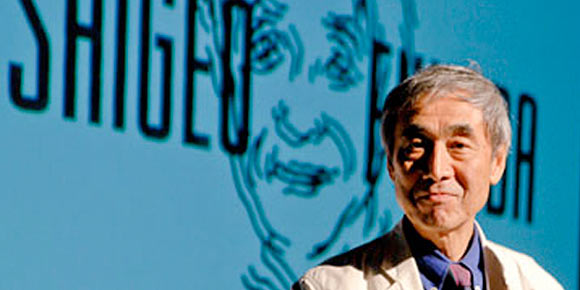
Shigeo Fukuda was a celebrated twentieth century sculptor, graphic artist and poster designer who also created efficacious optical illusions. An interesting thing about his artwork is that they usually depict deception. Lunch With a Helmet On is his quintessentially curious piece of art comprised of forks, knives, and spoons, casting a motorcycle shadow.
On February 14, 1932, in Tokyo, Japan, Shigeo Fukuda was born to a family of toy manufacturers. At the conclusion of Second World War, he expressed his interest in the minimalist Swiss Style of graphic design. He attended National University of Fine Arts & Music to study designing. In 1956, he earned his graduation from the institute. In 1966, his work gained recognition for the first time at a Czechoslovakian graphic design competition. The following year, his creative genius graced many posters and had him commissioned for Montreal’s Expo 1967. However, it was not until later this year that his career reached its zenith.
Fellow Hall of Fame inducted, Paul Rand came across some of his work featured in an issue of Japanese Graphic Design Magazine. Rand fully aware of Fukuda’s true potential helped him exhibit his work for the first time in United States at New York City’s IBM Gallery. The exhibition showcased his meticulously made puzzle-like wooden sculptures which he originally created as playthings for his child. The event culminated in bringing him in the limelight as Rand interviewed him, subsequently, on Public television. His work is highly inspired by a pioneer in modem Japanese graphic design, Takashi Kohno. Kohno was assumed first Japanese designer possessing a curious personality, a combination of objectivity and creativity. The posters he designed heralded a new era of visual expressionism. Although controversial in nature, Kohno’s work was always highly regarded for its visually inspiring quality. He was the precursor to Fukuda’s own imprint on communication design.
Fukuda developed interest in illusionism, in 1960’s. Then he began writing a column on visual magic, titled “Have You Seen the Dragon?”, for a Japanese newspaper Ashai Newspaper. Subsequently, he was appointed in-charge of Idea Magazine‘s “Visual Circus”. It was bi-monthly magazine featuring entertaining issues on illusion. Fukuda’s posters are described by The New York Times as being compelling yet simple images distilled from complex concepts. He created the official poster for the World’s Fair in Osaka for commercial purpose. A poster created for Amnesty International featured a clenched fist interwoven with barbed wire, with the letter “S” in the word “Amnesty”. He is best recognized for his ‘Victory, 1945’ poster. It displays a projectile heading straight at the opening of the barrel of a cannon. His pair of Earth Day posters featured the Earth as a seed opening against a solid sea-blue background.
Fukuda received countless accolades for his invaluable contribution to graphic design. However, they were nothing compared to his achievement in 1987, when he was inducted into the Art Directors Club Hall of Fame in New York City. The Hall of Fame remembers him as “Japan’s consummate visual communicator”. It was an honor for him since he was the first Japanese designer chosen to be inducted with other eminent creative art directors belonging to different nations. Fukuda’s inspiring work dramatically collapses all cultural and linguistic barriers with his universally recognizable style. He firmly believed in sense of high moral responsibility as a graphic designer and the worldly causes his work mirrored and embraced is the testament of that. Suffering a subarachnoid hemorrhage, Shiego Fukuda passed away in January, 2009.

